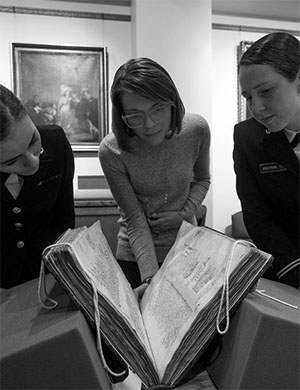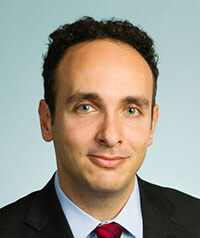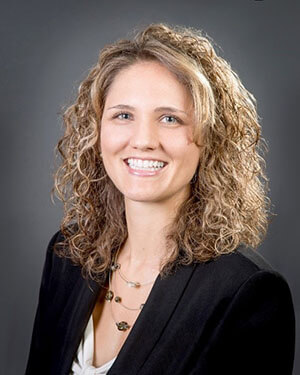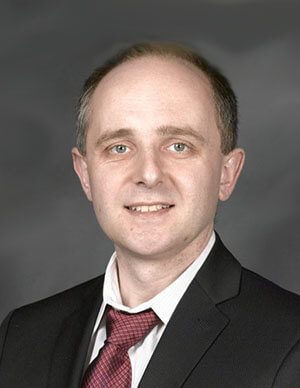USNA Faculty RESEARCH PROFILES
 |
|
CDR Brad Baker ’94, USN
Permanent Military Professor,
Mechanical Engineering
Director, Materials Laboratories,
Engineering & Weapons |
CDR Baker created the Naval Academy’s “MakerSpace,” which supports dozens of midshipman projects each year, including recent projects focused on putting 3D printers on naval ships, including a USNA Yard Patrol craft. This summer, CDR Baker and colleague Peter Joyce have turned a 2019 Capstone project into a patent application for additively manufactured detector. He has also established www.makerspaceusna.com, which will become the hub of 3D printing at the Academy.
“I believe my website will be a quantum leap in our teaching and capability,” says Baker. “I have designed a very comprehensive interface that directly includes teaching and instruction from other midshipmen (not USN and USMC officers) from the Class of 2019 as well as myself. I believe my website is critical to this submission and it has been my largest summer project. I also have large pending sponsorship grants from major industry partners to support the MakerSpace site that I hope secure through the Naval Academy Foundation this Academic Year.”
 |
|
Jill Fitzgerald, Ph.D.
Assistant Professor
of English |
Dr. Fitzgerald specializes in Old and Middle English, Old Norse-Icelandic and the History of the English Language. Her research, which has been supported by a privately funded Volgenau Fellowship, focuses on the literature and culture of early medieval England, especially Old English and Anglo-Latin texts from roughly the seventh through 11th centuries, with particular attention to biblical poetry, manuscripts and material culture, ecclesiastical history and conceptions of legal and political authority. She recently finished a book, Rebel Angels: Space and Sovereignty in Anglo-Saxon England, which investigates how early medieval authors adapted apocryphal and patristic accounts of the extra-biblical story of the fall of the angels in ways that allowed them to express cultural ideas concerning both ecclesiastical and secular power as well as attitudes toward inheritance and disinheritance. Her future research plans include articles on early medieval representations of the biblical warrior Judith, the Old English Illustrated Hexateuch, and the Scottish poet, Robert Henryson.
“Whenever I can, I enjoy introducing midshipmen to my research about the medieval world, whether through making medieval "Iron Gall" ink in one of the Naval Academy's chemistry labs, reciting and translating Old English with my classes or overseeing research projects on Viking sagas,” said Fitzgerald. “Through the generous support of the Naval Academy, I have taken numerous groups of midshipmen to the Folger Shakespeare Library in Washington, DC, to view their impressive medieval holdings and I annually lead a group of midshipmen on a walking pilgrimage - just like the one described in Chaucer's Canterbury Tales - from London to the city of Canterbury, UK. While ambling through the English countryside, midshipmen get to view castles, ancient monasteries, medieval churches, and, of course, the breathtaking Canterbury Cathedral.”
 |
|
Jeff Kosseff
Assistant Professor,
Cybersecurity Law |
With support from a two-year, $200,000 Andrew Carnegie Fellowship from the Carnegie Corporation of New York, Jeff Kosseff is currently writing United States of Autonomous Speech, his second book for Cornell University Press, which traces the history of the legal right to anonymous speech in America, from the pre-Revolutionary War political pamphlets to modern anonymous online communications systems such as Tor.
"I developed an interest in the legal right to anonymity while teaching a seminar for cyber operations majors, “Free Speech in Cyberspace,” says Kosseff. “For a full week, the midshipmen debated the merits of the broad rights to anonymity provided under the First Amendment, and we compared these rights to the more limited protections in other countries. My book provides the first in-depth history of the origins and impacts of this extraordinary First Amendment right, and I plan to use incorporate the research into the seminar this fall."
 |
|
Samar Malek, Ph.D.
Associate Professor,
Mechanical Engineering |
Dr. Malek’s research focuses on the structural design and analysis of gridshells—lattice shell structures made by bending a flat lattice of linear members in a curved surface—for use as deployable, large-span structures in humanitarian assistance/disaster relief (HA/DR). She uses engineering theory, computer programming and modeling and physical prototyping to study how gridshells perform in disaster scenarios.
“I have developed new collaborations with the Naval War College’s (NWC) Civilian-Military Humanitarian Response Program, broadening my understanding of the Navy’s role in HA/DR and providing me with the correct framework for my research questions,” says Malek. “My students have been heavily involved in my research from participation in multiple Capstone and Independent Research Projects to a three-day disaster simulation run by the NWC and Harvard Humanitarian Initiative. I also advised a 2019 Trident Scholar, MIDN Thomas Imhoff ’19, who later won a Gates Cambridge Scholarship, as he researched strucutal bracing methods for the use of gridshell structures in HA/DR.”
 |
|
Ines Martin, Ph.D.
Assistant Professor,
of German, Languages
and Cultures |
Dr. Martin’s research in the field of Applied Linguistics focuses on facilitating classroom-based language learning. The project she is working on this summer is a collaborative study between the Naval Academy Yale University and Penn State University, helping to shed light on the role of peer corrective feedback in beginner language classrooms. Dr. Martin collected speech recordings from two language courses at the Academy during the spring semester and is taking these data to Germany this summer, with resources provided by the Volgenau Funds, in order to collect native speaker ratings of learners’ foreign language pronunciation gains.
“The data I am collecting this summer will allow us to answer several important questions about the best ways to employ peer corrective feedback to facilitate language learning in a classroom setting,” says Martin. "Midshipmen directly benefit from the findings of this multi-site study. Not only do they gain valuable insight into the research that informs their learning every day through their participation in this study, but future generations of midshipmen who learn languages at the Academy will benefit from the practical recommendations based on the results of this research project.”
 |
|
Charles Nelson '96, Ph.D.
Associate Professor,
Electrical and
Computer Engineering |
Dr. Nelson has enjoyed working this spring and summer on laser research with MIDN Jeff Sonberg ’20 using equipment funded in part by the Volgenau Funds. MIDN Sonberg has been actively pursuing laser research, exploring scintillation reduction of lasers propagating through underwater channels using multi-emitter beam combination. MIDN Sonberg, who is prior enlisted, (Navy) recently finished an internship on laser lethality at Dahlgren, VA. While at Dahlgren, he worked with some of the latest Navy laser technology and hopes to be able to apply his knowledge of lasers to his research as well as in the fleet after graduation.
"Directed energy is a vital element for the U.S. Navy now and into the future,” says Nelson. “ Having opportunities for undergraduate students such as Jeff to intern and actively research laser topics and applications will pay great dividends for our nation's future warfighters."
 |
|
Ina O'Carroll, Ph.D.
Associate Professor,
Chemistry |
Dr. O’Carroll and her students study HIV and human endogenous retroviruses (HERVs). HERVs are HIV-like DNA sequences that are part of our own genome and have been associated with various cancers and neurodegenerative and autoimmune diseases (such as ALS and MS). Together with midshipmen and in collaboration with scientists at the National Institutes of Health and USNA, Dr. O’Carroll has solved the three-dimensional structure of a region in the HERV RNA genome that is necessary for HERV protein production. This is the first three-dimensional structure of a HERV molecule. It can be used to develop new therapeutics that target HERV RNA, thus blocking the production of HERV proteins associated with pathology. The work has been supported by a generous gift from Dr. Ned Garrigues, MD, Class of 1968, to Midshipman Erin McShane, class of 2019, a rising medical student at Stanford University.
“Being able to conduct research on human retroviruses at USNA has allowed me to pursue an exciting and largely unexplored biomedical research area while training the next generation of science-savvy leaders,” says O’Carroll.
 |
|
John Polga-Hecimovich, Ph.D.
Assistant Professor,
Political Science |
Dr. John Polga-Hecimovich’s recent research has focused on bureaucratic politicization and its effect on public opinion in Latin America. Using survey data from Venezuela, his research shows that public opinion approval of the government exercises a significant effect on confidence in their armed forces. His research was recently published in the Latin American Research Review (LARR), and he also shared some of his findings with mid-career Foreign Area Officers at U.S. Southern Command in June 2019. Because of the lack of research funds, Polga-Hecimovich self-funded his accommodations at a conference in the last year to present and get feedback on his work from other scholars. He plans on using this research in the classroom with midshipmen as an example of the dangers of military politicization for civil-military relations and military effectiveness.
“Professionally, this research has opened doors for me," says Polga-Hecimovich. "Already, I have had the opportunity to share my findings with mid-career Foreign Area Officers at U.S. Southern Command. Furthermore, I look forward to using this in my classroom as an example of the dangers of military politicization for civil-military relations and military effectiveness."
 |
|
Jacek Rothert, Ph.D.
Associate Professor,
Economics |
Originally from Poland and applying for an EB-1 Visa as an Outstanding Professor and Researcher, Dr. Rothert began teaching at the Academy in 2014 and has been promoted to Associate Professor. He is an expert in international macroeconomics with an emphasis on China and has a strong teaching and research record. He advised Trident Scholar Midshipman Davis Katakura ’19 on his project, "China's Export Effects: A Product-Level Analysis of Global Supply Chains, Comparative Advantage, and Crowding-Out,” has a number of ongoing research projects with Katakura and faculty colleagues from the Economics and Mathematics Departments. He also recently published an article he worked on with now-Ensign Ethan White ’17, USN. His conference travel has been heavily supported by gifts from the Fluegel and Looker families.
“My current research focuses on the impact that China's entry into the global economy had on the economic growth of other developing countries,” says Rothert. “This is a fascinating and challenging question that can be addressed by analyzing a big data set of trade flows between countries, combined with theoretical models of economic growth. It is closely linked to my older research on Chinese persistent trade surpluses (mirrored by U.S. trade deficits), and on the potential costs and benefits of removing them. Midshipmen are naturally interested in China which is already considered the major strategic challenge for the United States, and will most likely become the world's largest economy within the next 10-15 years. I always try to "sneak in" some excerpts from my work into the classes I am teaching. That way midshipmen get the most up-to-date information on the topics we discuss in class and, hopefully, a few of them get inspired to get their hands dirty with their own research projects in economics.”
 |
|
Ron Warzoha, Ph.D.
Associate Professor,
Mechanical Engineering |
Dr. Warzoha is currently exploring the impacts of nanostructuring on the mechanisms that govern thermal transport in a variety of electronic materials. To explore this experimentally, Dr. Warzoha’s research team in the NEaTT (Nanoscale Electronic and Thermal Transport) Lab relies on state-of-the-art optical pump-probe techniques called Time-domain Thermoreflectance and Frequency-domain Thermoreflectance. These techniques allow the team to probe at length scales on the order of nanometers and time-scales that range from femtoseconds to nanoseconds. Recently, Dr. Warzoha and Trident Scholar Midshipman Nicholas Vu ’19 utilized these experimental techniques to better understand the role of grain boundary size on the thermal transport properties of a Nickel Titanium (NiTi) shape memory alloy across temperatures that span a phase transition region. The results from this study are expected to have a profound impact on the design of next-generation elastocaloric cooling systems and phase change thermal energy storage materials. Several additional works generated from the NEaTT Lab can be found at www.usnathermal.com.